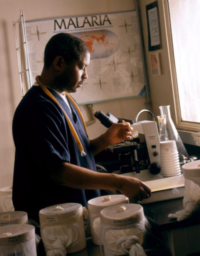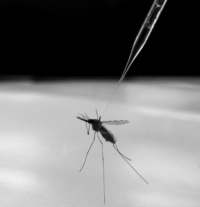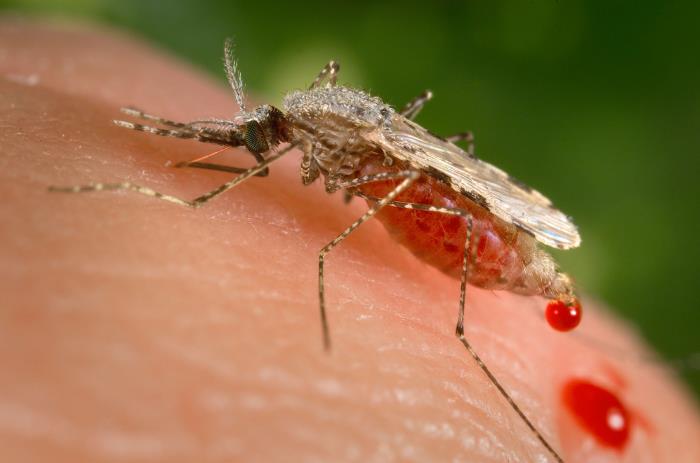Responding to
Anopheles stephensi
PMI Action Plan, reference materials, guidance documents, and other resources for all partner countries to respond to the threat of An. stephensi in Africa.
Anopheles stephensi is an invasive malaria mosquito in Africa with a unique ecology allowing it to thrive in urban habitats as well as rural habitats and persist throughout dry seasons. This invasive vector threatens to alter the landscape of malaria from a predominantly rural disease to one that impacts both rural and urban populations. It is estimated that as this species continues to spread throughout the African continent, it could put an additional 126 million people in urban areas at risk of malaria. In 2011, Djibouti was successfully progressing toward malaria elimination; however, in 2012, An. stephensi was detected and since then malaria has increased 36-fold, with over 300,000 suspected cases in 2020, in a country of fewer than 1 million.
PMI revised its policy around larval source management (LSM), and in countries where An. stephensi has been confirmed, LSM may be implemented as a vector control intervention. This provides opportunities for PMI partner countries to respond to An. stephensi quickly.
To support countries in making decisions about how best to address this biological threat, PMI’s An. stephensi Task Force, comprising of representatives from different technical areas and from affected countries, developed a living Action Plan document, which contains reference material, protocols, and proposed activities for decision making around An. stephensi and aligns with the WHO initiative to stop the spread of An. stephensi in Africa.
To support the global community in tracking the spread of An. stephensi, PMI partner countries are conducting enhanced surveillance for An. stephensi. We are working with our partners to investigate suspected specimens collected through routine surveillance in the hundreds of PMI supported entomological monitoring sites- and to report surveillance sites (both positive and negative for An. stephensi) to WHO to generate the data needed to track the spread of the species on the continent.
PMI has also supported the development of a cross-cutting social and behavior change (SBC) guidance document which can be used by partner countries once a response to An. stephensi has been identified. SBC activities should be incorporated within the response to promote the interventions and associated individual, household, and community level behaviors that support the uptake and maintenance of interventions to combat invasive An. stephensi.
PMI Action Plan to respond to the threat of Anopheles stephensi in Africa
In 2021 PMI stood up a task force with representatives from different technical areas and affected partner countries to adapt PMI’s strategy to address An. stephensi with urgency across all technical areas and to determine policy changes, strategic documents, and operational research necessary to mitigate the impact on malaria transmission.
In response, an Action Plan was developed and the PMI approach at this time focuses on mitigation of the harmful effects of An. stephensi utilizing enhanced vector and disease surveillance, coordinated intervention implementation, and close monitoring.

Predicting impact on malaria
Ethiopia was the first PMI partner country to confirm the presence of An. stephensi; however, the impact of the species on malaria cases and the cost of control interventions were not clear. To address these questions, PMI supported a modeling study which extrapolated data from Djibouti on An. stephensi and malaria to Ethiopia with consideration for habitat suitability, the cost of vector control interventions, Plasmodium parasite transmission, and known detection sites. This modeling study showed that if An. stephensi were to spread throughout Ethiopia into all suitable habitats, a 50% increase in P. falciparum malaria would likely occur, costing an additional $72 million dollars per year in vector control interventions.

Resources
Resources and reference material:
Peer reviewed publications:
Key to Afrotropical Anopheles mosquitoes including An. stephensi morphological key (Coetzee 2020)
Predicting range expansion of An. stephensi in Africa (Sinka et al. 2020)
An update on Anopheles stephensi in Ethiopia, 2018–2020 (Balkew et al. 2020)
Molecular tools for early detection of An. stephensi invasive mosquitoes (Singh et al. 2023)
Marine cargo traffic and habitat suitability predict countries at risk of invasion by An. stephensi (Ahn et al. 2023)
Potential impact of An. stephensi on malaria in Ethiopia using modeling shows 50% increase in P. falciparum malaria and costs of and additional $72M per year for vector control alone (Hamlet et al. 2023)
Climate change and thermal range of An. stephensi would put ~⅓ of the world’s population within transmission range. (Ryan et al. 2023 preprint)
What sounds like Aedes, acts like Aedes but is not? Lessons learned from dengue for the control of An. stephensi (Allan et al. 2022)
A missed opportunity: An. stephensi in Africa (Samarasekera et al. 2022)
WHO documents:
WHO initiative to stop the spread of An. stephensi
Vector alert: Anopheles stephensi invasion and spread (who.int)
WHO threats map to visualize detection locations
WHO 2019 technical consultation
ALL An. stephensi surveillance sites should be reported to WHO even if detections are negative using this reporting form emailed to vectorsurveillance@who.int. Detections should be reported immediately.
Anopheles Stephensi in the News
This urban mosquito threatens to derail the fight against malaria in Africa
An Invasive Mosquito Threatens the Progress to End Malaria in Africa
Unusual malaria outbreak tied to invasive mosquito | Science | AAAS
An Invasive Mosquito Threatens Catastrophe in Africa
Invasive malaria mosquito spreading in Africa, researchers warn
Stories From the Field
VIDEO: Addressing the threat of Anopheles stephensi
See how PMI is working with countries to develop effective ways to detect, monitor, and control the spread of this invasive malaria mosquito in Africa.
Researchers on the Frontlines Tracking the Spread of a New Mosquito in Nigeria
Nigerian researcher Dr. Auwal Al-Hassan studies mosquitoes to learn about their behavior and how to stop them from spreading malaria. His current research focuses on the invasive Anopheles stephensi mosquito, and what he and fellow researchers discover could have profound implications for the future of malaria in their country.
An Invasive Mosquito Threatens the Progress to End Malaria in Africa
PMI is helping to lead the response in Ethiopia against Anopheles stephensi




